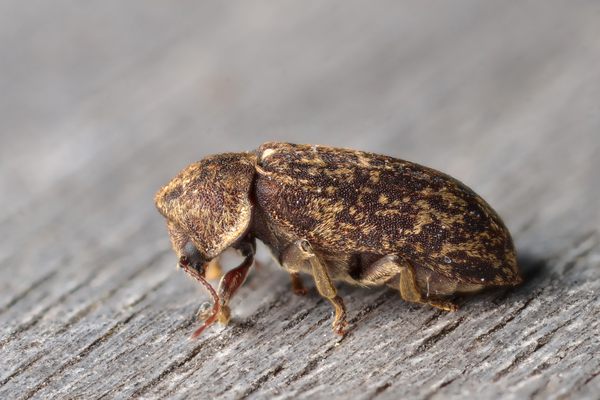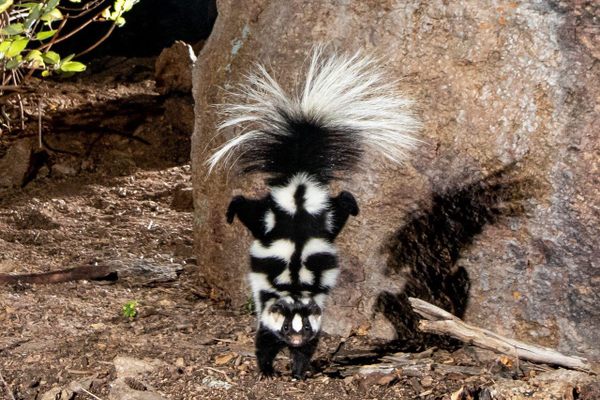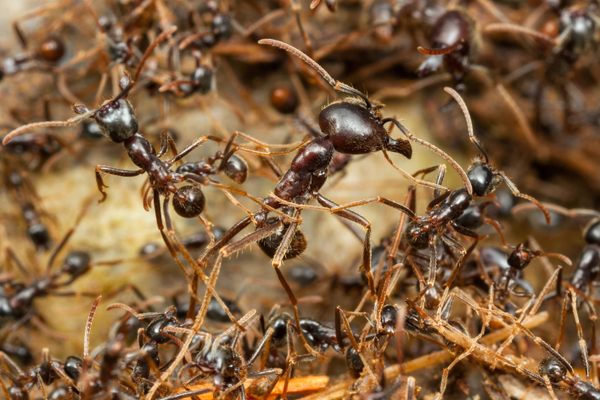Backyard Bugs: LA’s Unsung Biodiversity
Sitting in gridlock watching wildfires burn in the distance, it’s easy to fall victim to the stereotype of Los Angeles as an apocalyptic wasteland. Freeways, parking lots, and stripmalls make it difficult to imagine LA as an ideal location for studying biodiversity. And yet somehow, in this collision of urban and natural environments, there are species that thrive. To understand this unique environment, the Natural History Museum (NHM) launched Biodiversity Science: City and Nature (BioSCAN), a research project exploring the insect biodiversity of Los Angeles.
Entomologist Lisa Gonzalez of BioSCAN shares stories of LA insects (photo by Erin Johnson)
On July 30, Obscura Society LA gathered at Center for the Arts Eagle Rock for an evening of six-legged exploration. This two-part event began with a lecture from BioSCAN and ended with a hands-on insect pinning workshop.
Several insects cataloged by BioSCAN, including the Robber Fly (top left corner), known for stealing the life of other insects in mid-air (photo by Kelsey Bailey)
BioSCAN is a three-year research project that aims to examine the insect biodiversity of Los Angeles. Collecting weekly samples from 30 sites across the city, their goal is to identify and map species, and to understand how they are affected by urban development. BioSCAN entomologist Lisa Gonzalez described the project and revealed they had uncovered many new species. While their identity remains a secret until their debut in forthcoming publications, she did introduce us to some other charismatic creatures collected from the project whose roles ranged from cadaver decomposition to plant fertilization.
Meet the bugs of BioSCAN:
The Coffin Fly: Smelling a corpse with her antennae, the Coffin Fly can dig six feet down to lay her eggs on a body (photo by Kelsey Bailey)
The mason bee’s brilliant metallic color comes from the structure of it’s exoskeleton. One of over 500 species of bees living in LA! (photo by Phyllis Sun)
The Bumble Bee: While there are 26 species of bumble bees species in LA, this is the only individual collected so far. The BioSCAN team cites “commercial keeping of bumble bees, habitat loss, pollution, and climate change” as reasons for their decline. (photo by Phyllis Sun)
The Fig Wasp: Bound together in obligate mutualism, the fig wasp & the fig cannot survive without each other. (photo by Kelsey Bailey)
The Botfly: The appearance of this “furry teddy bear” in the collection sample triggered a Happy Fly Dance in the BioSCAN lab. This particular botfly, Cuterebra latifrons, requires the Dusky-footed wood rat to complete its lifecycle. (photo by Kelsey Bailey)
Drawers of specimens from NHM’s entomology collection (photo by Erin Johnson)
The Obscura Society crowds around the specimen boxes while Lisa Gonzalez answers questions (photo by Erin Johnson)
Tiny specimens from NHM’s entomology collection (photo by Erin Johnson)
Beetles from NHM’s entomology collection (photo by Erin Johnson)
Suzanne Berhow explains the art of insect pinning (photo by Erin Johnson)
The insect pinning workshop was lead by Suzanne Berhow, an active member of the taxidermy world and an artist known for her carefully crafted and beautiful pinned insects. This hands-on experience allowed the Obscura Society an up-close look at a few local bugs including a Mourning Cloak butterfly, a Milbert’s Tortoiseshell butterfly, and several varieties of beetles and bees.
Captivated audience (photo by Erin Johnson)
Suzanne assists with abdomen placement while Matt Blitz, Head of the Obscura Society LA contemplates antenna position (photo by Erin Johnson)
Carefully placing pins, trying not to disturb the tiny, pigmented scales (photo by Erin Johnson)
Butterfly pinning workspace illuminated by an iPhone with a 3D lenticular cover of the Endeavor Space Shuttle. Can we add raindrops on roses and whiskers on kittens to this scene? (photo by Erin Johnson)
After drying for 24 hours, pins & papers were removed (photo by Erin Johnson)
S the next time you’re feeling trapped in a concrete jungle, turn off the freeway and discover a secret world buzzing with metallic bees and furry flies. Thank you, Suzanne Berhow, Lisa Gonzalez, and the entire BioSCAN team for sharing LA’s beautiful, backyard bugs!
LEARN MORE:
Build Your Own Mason Bee House
Erin Johnson is a Scientific Illustrator and Atlas Obscura Field Agent living in Los Angeles, CA. You can see more of her work at her website.
The Obscura Society is the real-world exploration arm of Atlas Obscura We seek out secret histories, unusual access, and opportunities for our community to explore strange and overlooked places hidden all around us. Join us on our next adventure, and keep up with LA Obscura Society events on our mailing list.



























Follow us on Twitter to get the latest on the world's hidden wonders.
Like us on Facebook to get the latest on the world's hidden wonders.
Follow us on Twitter Like us on Facebook